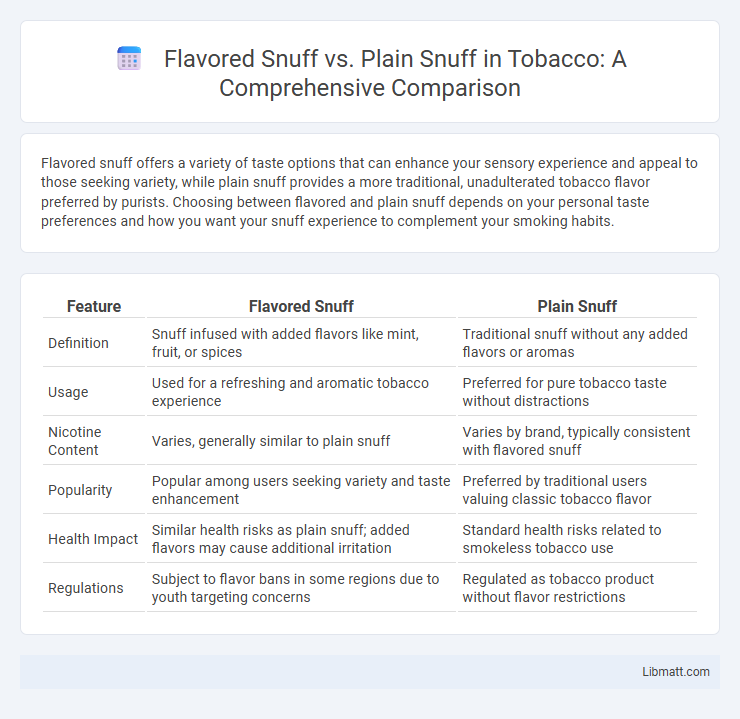Flavored snuff offers a variety of taste options that can enhance your sensory experience and appeal to those seeking variety, while plain snuff provides a more traditional, unadulterated tobacco flavor preferred by purists. Choosing between flavored and plain snuff depends on your personal taste preferences and how you want your snuff experience to complement your smoking habits.
Table of Comparison
| Feature | Flavored Snuff | Plain Snuff |
|---|---|---|
| Definition | Snuff infused with added flavors like mint, fruit, or spices | Traditional snuff without any added flavors or aromas |
| Usage | Used for a refreshing and aromatic tobacco experience | Preferred for pure tobacco taste without distractions |
| Nicotine Content | Varies, generally similar to plain snuff | Varies by brand, typically consistent with flavored snuff |
| Popularity | Popular among users seeking variety and taste enhancement | Preferred by traditional users valuing classic tobacco flavor |
| Health Impact | Similar health risks as plain snuff; added flavors may cause additional irritation | Standard health risks related to smokeless tobacco use |
| Regulations | Subject to flavor bans in some regions due to youth targeting concerns | Regulated as tobacco product without flavor restrictions |
Introduction to Snuff: Flavored vs Plain
Flavored snuff offers a variety of tastes such as mint, fruit, and spice, enhancing the sensory experience compared to plain snuff, which maintains a traditional tobacco flavor without additives. Both types are finely ground tobacco products used nasally, but flavored snuff appeals to users seeking variety and masking the strong tobacco taste. Plain snuff remains favored by purists who prefer the unaltered, robust tobacco aroma and nicotine delivery.
Historical Background of Snuff Varieties
Flavored snuff and plain snuff have distinct historical origins shaping their usage and popularity. Plain snuff, originating in the 16th century, was primarily used for its nicotine content and medicinal properties. Flavored snuff emerged in the 18th century, incorporating aromatic ingredients like menthol, citrus, and floral essences to enhance appeal and mask the natural harshness of tobacco.
Key Ingredients in Flavored and Plain Snuff
Flavored snuff typically contains added natural or artificial flavorings such as menthol, fruit extracts, or spices alongside core ingredients like ground tobacco and alkaline agents, enhancing its sensory appeal. Plain snuff consists primarily of finely ground tobacco leaves and basic preservatives, without additional aromas or taste enhancers, targeting users who prefer unadulterated tobacco flavor. Understanding the key ingredients helps you choose between a more aromatic experience or a traditional tobacco taste.
Sensory Experience: Aroma and Taste Comparison
Flavored snuff offers a diverse sensory experience with aromas ranging from fruity and minty to spicy, enhancing the taste profile and making each use more engaging. Plain snuff provides a traditional, robust tobacco flavor with earthy and smoky notes, appealing to purists who prefer a straightforward sensory experience. Your choice between flavored and plain snuff significantly impacts the aroma and taste, catering to either adventurous palates or classic tobacco enjoyment.
Popular Flavored Snuff Varieties
Popular flavored snuff varieties include classic options like mint, wintergreen, and cherry, which enhance the tobacco experience with refreshing and sweet undertones. Fruit flavors such as berry, apple, and citrus are also widely favored for their vibrant and aromatic profiles. Choosing flavored snuff can add a personalized dimension to your snuff use, compared to the traditional, straightforward taste of plain snuff.
Health Considerations: Flavored vs Plain Snuff
Flavored snuff often contains added chemicals and artificial sweeteners that may increase the risk of respiratory irritation and allergic reactions compared to plain snuff, which generally has fewer additives. Both types carry health risks related to nicotine exposure, including increased heart rate and potential for addiction, but flavored varieties might exacerbate oral health issues due to their chemical composition. Your choice between flavored and plain snuff should consider these health implications, with plain snuff potentially posing fewer risks linked to added flavoring agents.
User Preferences and Market Trends
Flavored snuff attracts users seeking diverse taste experiences, often appealing to younger demographics with options like fruit, mint, and spice flavors, while plain snuff remains favored among traditional users valuing a classic, unaltered tobacco taste. Market trends show a growing demand for flavored varieties driven by innovation and marketing strategies targeting flavor-conscious consumers, contrasting with a stable but niche market for plain snuff rooted in heritage and authenticity. Understanding your preferences can help navigate these options, whether you prioritize modern flavor experimentation or time-honored simplicity.
Regulatory Perspectives on Snuff Flavors
Regulatory perspectives on flavored snuff differ significantly across regions, with many countries imposing restrictions or bans on flavor additives to reduce appeal to youth and non-smokers. Plain snuff often faces fewer regulatory constraints as it lacks enticing flavors, aligning with policies aimed at minimizing tobacco initiation. Authorities prioritize public health by targeting flavored snuff, which is commonly associated with increased usage and addiction potential due to its palatability.
Cultural Significance of Snuff Choices
Flavored snuff holds cultural significance by often reflecting regional tastes and social rituals, with ingredients like menthol, fruit, or spices catering to specific ethnic or community preferences. Plain snuff typically represents traditional or historical usage, emphasizing purity and a connection to heritage in indigenous or older populations. The choice between flavored and plain snuff can signify identity, social status, and adherence to cultural customs within various societies.
Choosing Between Flavored and Plain Snuff
Choosing between flavored and plain snuff depends on individual preferences for taste and nicotine experience. Flavored snuff offers a variety of aromatic options like mint, fruit, or spice, enhancing sensory enjoyment and masking the natural tobacco bitterness. Plain snuff delivers a traditional, robust nicotine hit without added flavors, appealing to purists seeking an authentic tobacco experience.
Flavored snuff vs Plain snuff Infographic

 libmatt.com
libmatt.com